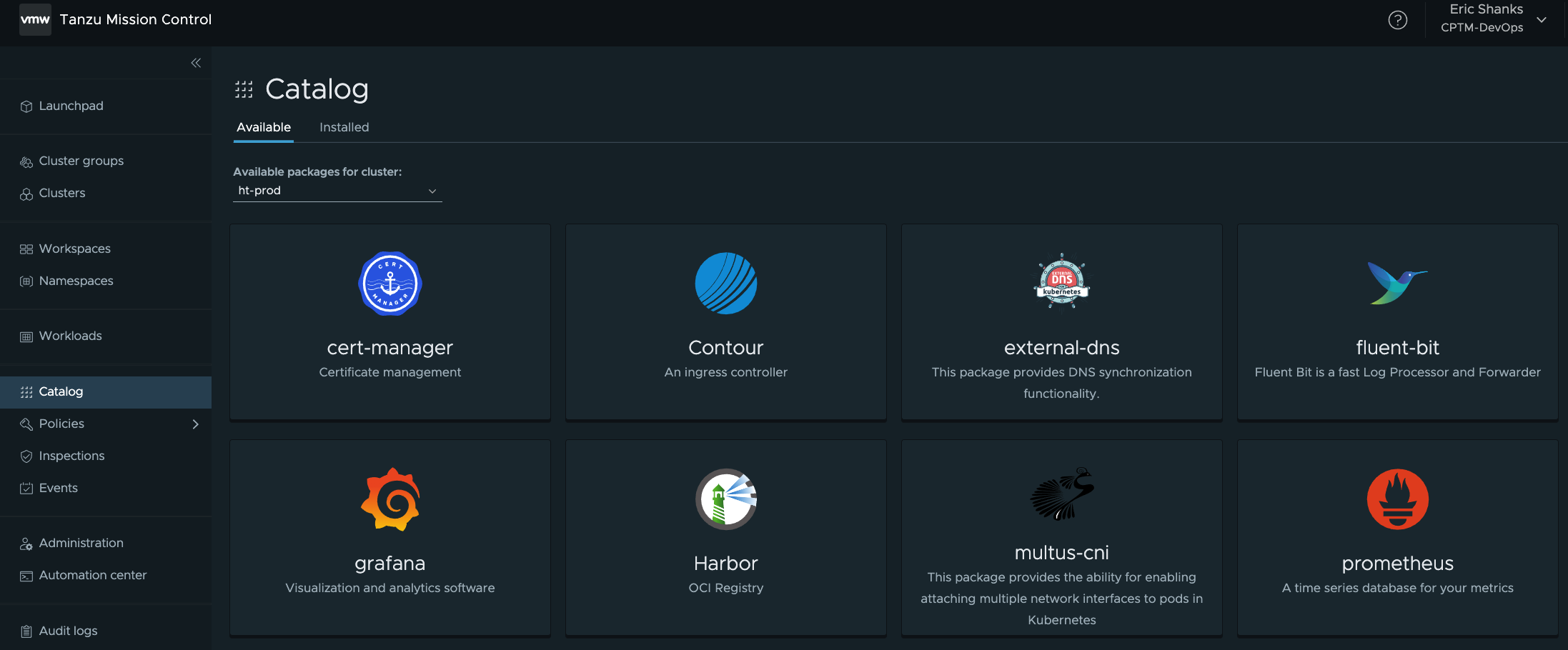Configure Kubernetes Logging from the Tanzu Mission Control Catalog
Configure Log Forwarding through Tanzu Mission Control Catalog Packages
Deploying Kubernetes resources usually involves creating or editing YAML manifests in a text editor before finally applying a desired state to the cluster. A YAML manifest saved in version control is a great way to manage configuration options in your Kubernetes clusters, but this might not be the preferred option for some organizations.
Tanzu Mission Control announced a new "Catalog" capability where platform operators can select an application from the catalog and deploy it to one of their Kubernetes clusters managed by Tanzu Mission Control. VMware provides a list of packages included with your TMC version to help you get your clusters up and running with little effort. Things like ingress routing with Contour, cert-manager for applying TLS certificates to your apps, Fluent-bit for logging, and Prometheus for monitoring, to name a few.
This post focuses on one of these packages (fluent-bit) and how you can use the catalog to deploy fluent-bit to your Kubernetes clusters and push logs to vRealize Log Insight Cloud.
Deploy the Fluent-bit Package
Log in to the Tanzu Mission Control portal and select the "Catalog" menu item to deploy a package from the catalog. The catalog screen will open and prompt you to deploy the package on a cluster. Then select the package you wish to install. For this post, we'll use the fluent-bit package.

Once you've selected the package and the cluster, you will be presented with a new screen that shows details about the package, including version and release notes. The most important part of this screen is the configuration values. These configuration values show what variables can be changed, or are required, to deploy your packages. This screen is purely informational, but you'll need to configure these values in the next step.

Tanzu Mission Control will now prompt you for deployment information in a wizard-based menu. Give the package a deployment name and select a package version. Click "Next."

On the next screen, you'll be prompted with some radio buttons. You should be able to leave these settings the default if you're just getting started, but you can change the package's namespace to a custom namespace if you like.
NOTE: this namespace is for the package object and NOT the actual package contents. For example, we might deploy this package to a "Packages" namespace. However, Fluent-bit itself might still be deployed into a logging namespace or wherever you decide to set that variable (seen in the next phase).

Once you've decided about your package resources, you'll need to set the configuration values for the package. These values were shown during a previous step and are shown again here with an option to modify them. It should be noted that these configuration values will change depending on the type of package used. In our case, we need to make a few changes to the default fluent-bit configuration to push logs to vRealize Insight Cloud using our API token.

In my case, I needed to change the configurations for the "fluent_bit" object. My full configuration is shown below, which I've pasted into the "Configured values" section.
fluent_bit:
config:
service: |
[Service]
Flush 3
Log_Level info
Daemon off
Parsers_File parsers.conf
HTTP_Server On
HTTP_Listen 0.0.0.0
HTTP_Port 2020
outputs: |
[OUTPUT]
Name http
Match *
tls On
tls.verify Off
Host data.mgmt.cloud.vmware.com
Port 443
URI /le-mans/v1/streams/ingestion-pipeline-stream
Header Authorization Bearer “Your-API-Token-Goes-Here”
Format json
inputs: |
[INPUT]
Name tail
Path /var/log/containers/*.log
Parser docker
Tag kube.*
Mem_Buf_Limit 5MB
Skip_Long_Lines On
[INPUT]
Name systemd
Tag host.*
Systemd_Filter _SYSTEMD_UNIT=kubelet.service
Read_From_Tail On
filters: |
[FILTER]
Name kubernetes
Match kube.*
Kube_URL https://kubernetes.default.svc:443
Kube_CA_File /var/run/secrets/kubernetes.io/serviceaccount/ca.crt
Kube_Token_File /var/run/secrets/kubernetes.io/serviceaccount/token
Kube_Tag_Prefix kube.var.log.containers.
Merge_Log On
Merge_Log_Key log_processed
K8S-Logging.Parser On
K8S-Logging.Exclude On
[FILTER]
Name modify
Match *
Rename message text
parsers: |
[PARSER]
Name json
Format json
Time_Key time
Time_Format %d/%b/%Y:%H:%M:%S %z
streams: ""
plugins: ""
#! optional configuration for the daemonset
daemonset:
resources:
#! limits:
#! cpu: 100m
#! memory: 128Mi
#! requests:
#! cpu: 100m
#! memory: 128Mi
podAnnotations: {}
podLabels: {}
Once your configuration is in place, click the "Install Package" button to begin the deployment.
Within the Tanzu Mission Control portal, you can look at the installed packages under the "Add-ons" tab of the cluster view. You can see from the screenshot below that two packages were already successfully deployed, and our fluent-bit package is in the process of being deployed.

Once the reconciliation loops are complete, you should see a "Succeeded" status message or an error with some information about what failed during the deployment.

If your fluent-bit configuration succeeded, you should start seeing logs in your vRealize Log Insight instance within a couple of minutes. Your next steps would be to build fancy dashboards or alerts out of those new logs that vRealize Log Insight is receiving.

Summary and Additional Resources
The Tanzu Mission Control catalog feature is a nice way to provide platform operators a GUI based method of deploying software to Kubernetes clusters. Platform operators can use these catalog items to configure any Kubernetes clusters registered with TMC so they can quickly update their fleet of clusters. VMware Cloud on AWS customers are entitled to this catalog feature for free with their Tanzu Mission Control Essentials licensing that comes with VMware Cloud on AWS.
Additional Resources
Tanzu Mission Control Documentation
Changelog
The following updates were made to this guide.
| Date | Description of Changes |
| 2022-01-03 | Initial publication |
About the Author and Contributors
Eric Shanks has spent two decades working with VMware and cloud technologies focusing on hybrid cloud and automation. Eric has obtained some of the industry's highest distinctions, including two VMware Certified Design Expert (VCDX #195) certifications and many others across various solutions, including Microsoft, Cisco, and Amazon Web Services.
Eric's acted as a community contributor as a Chicago VMUG Users Group leader, blogger at theITHollow.com, and Tech Field Day delegate.
- Eric Shanks, Sr. Technical Marketing Architect, Cloud Services Business Unit, VMware
